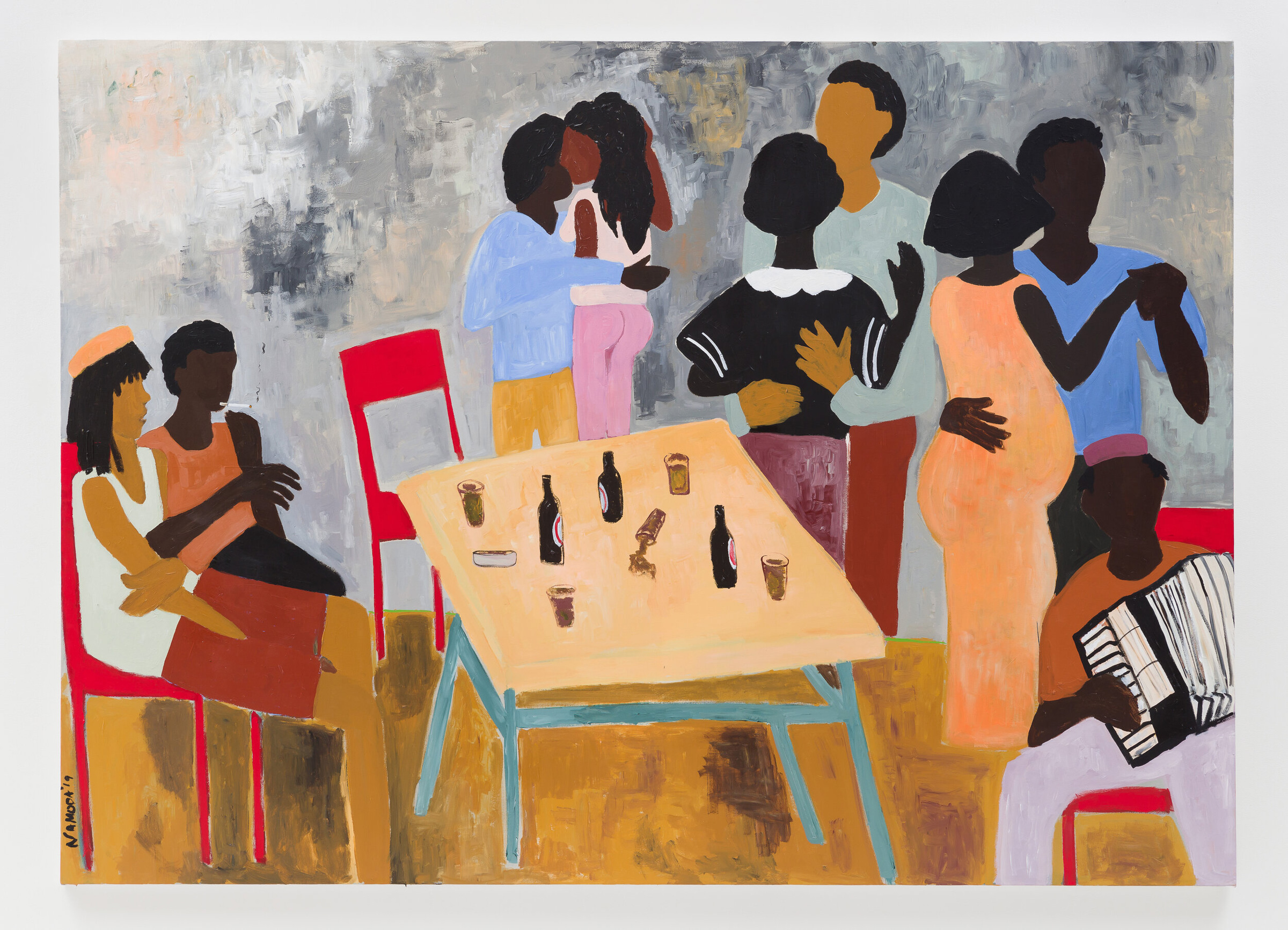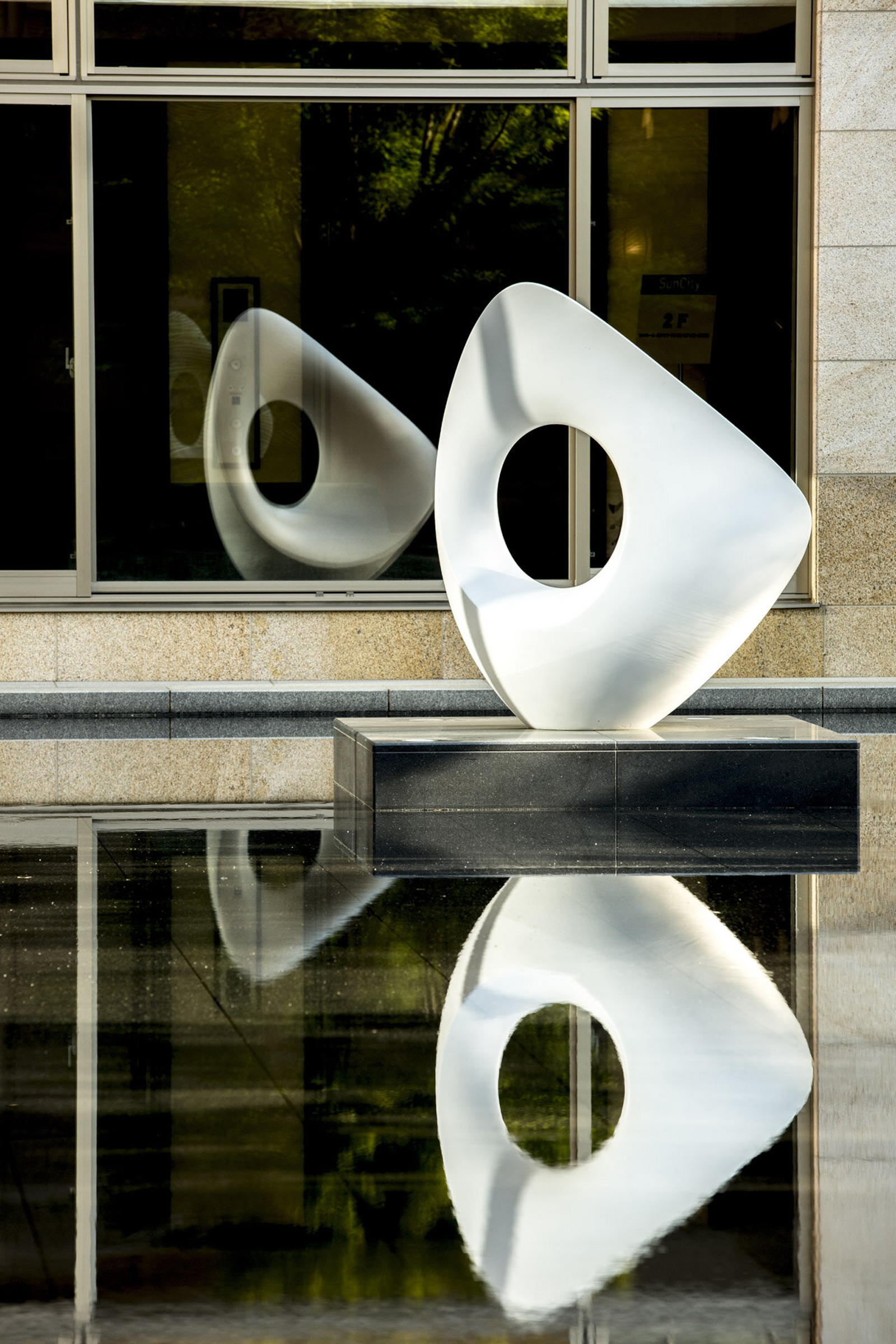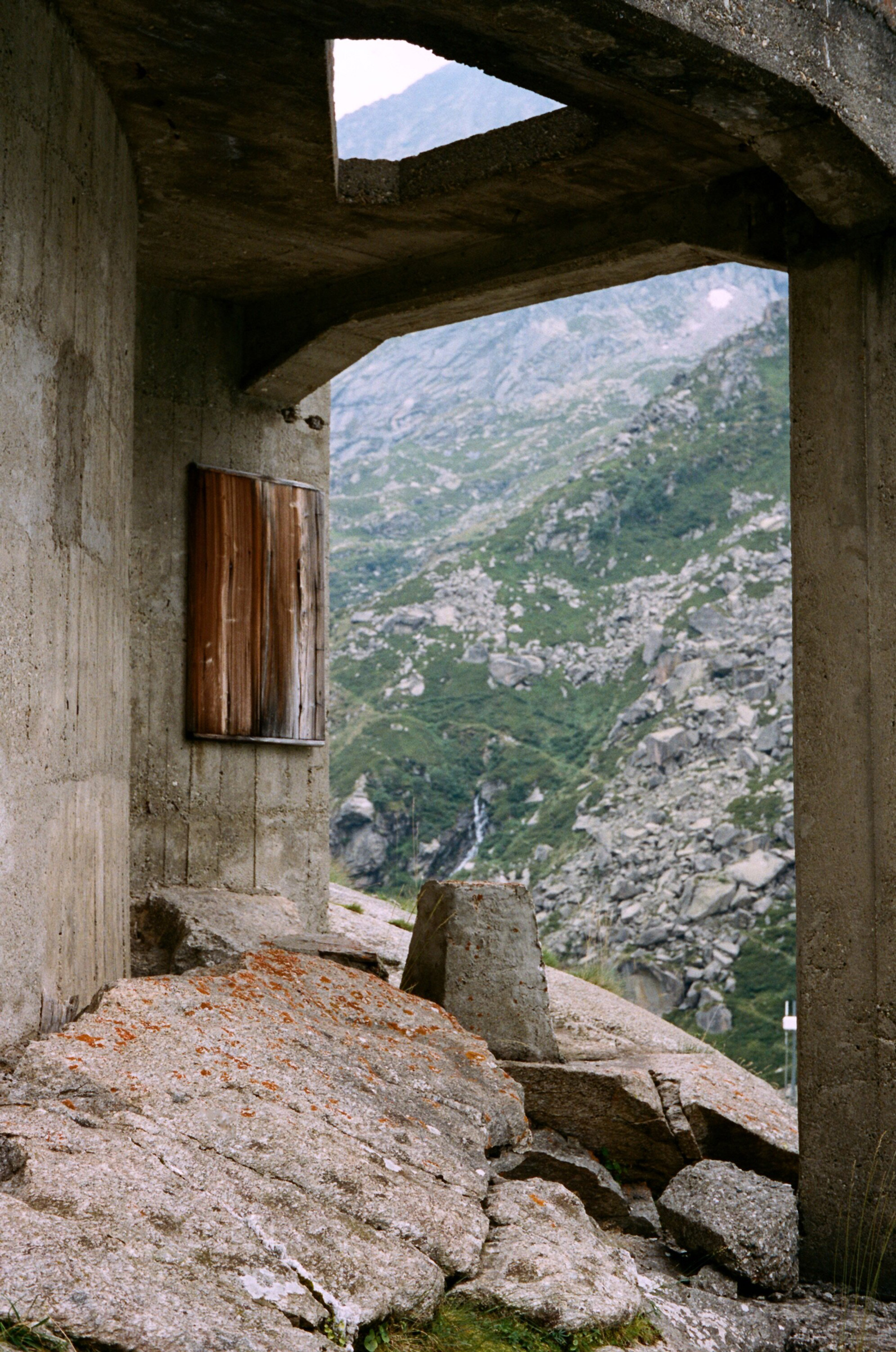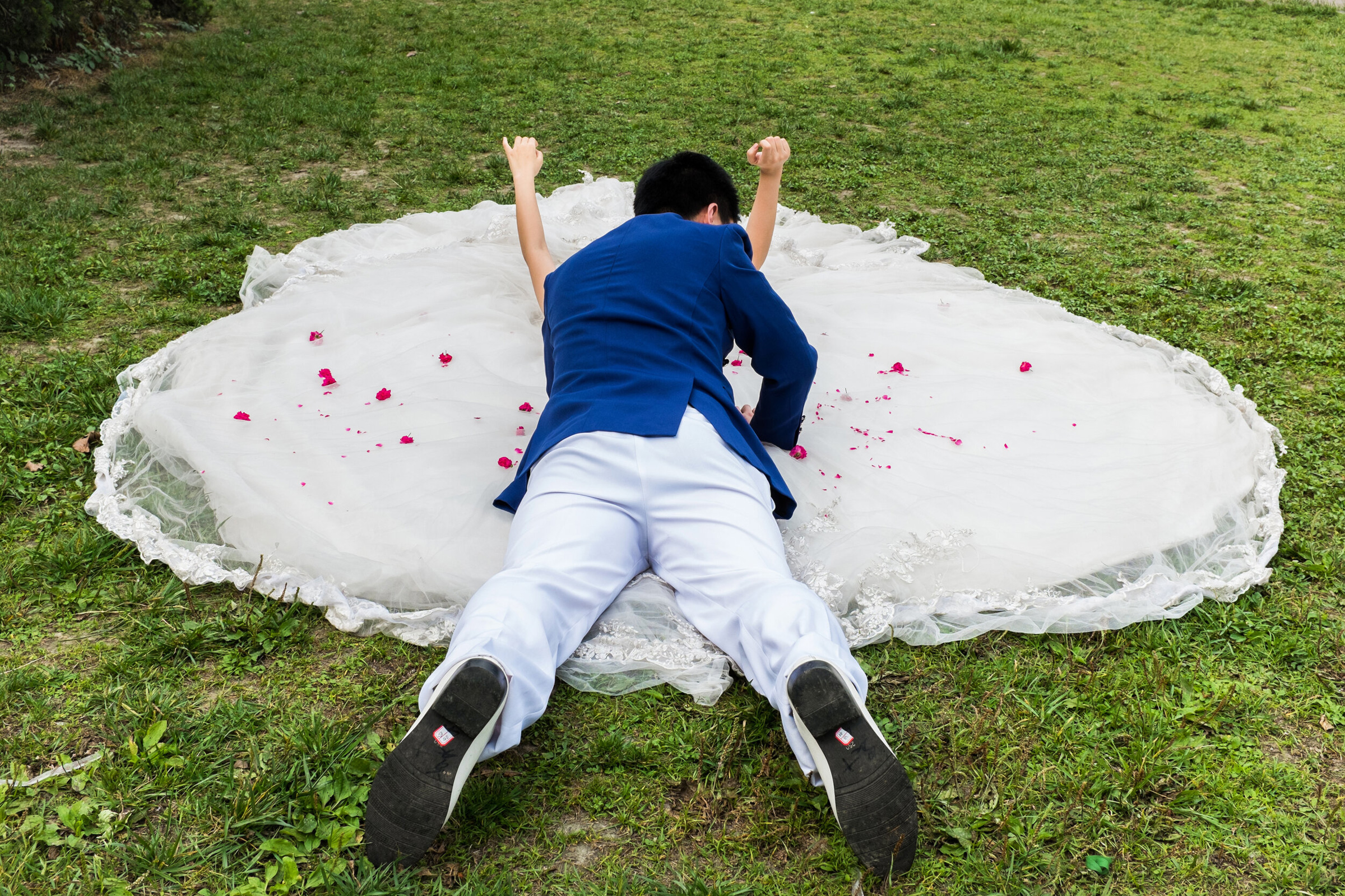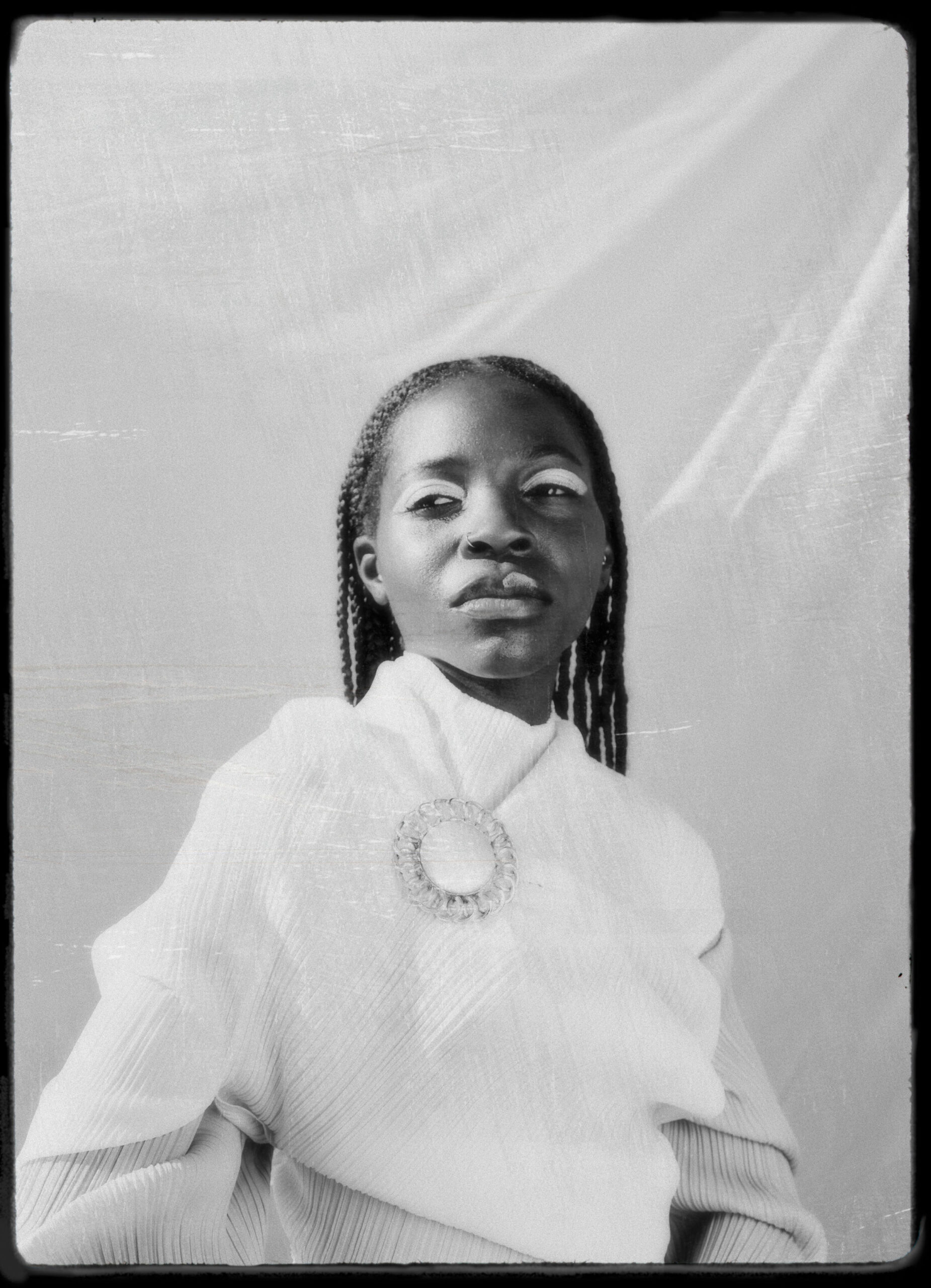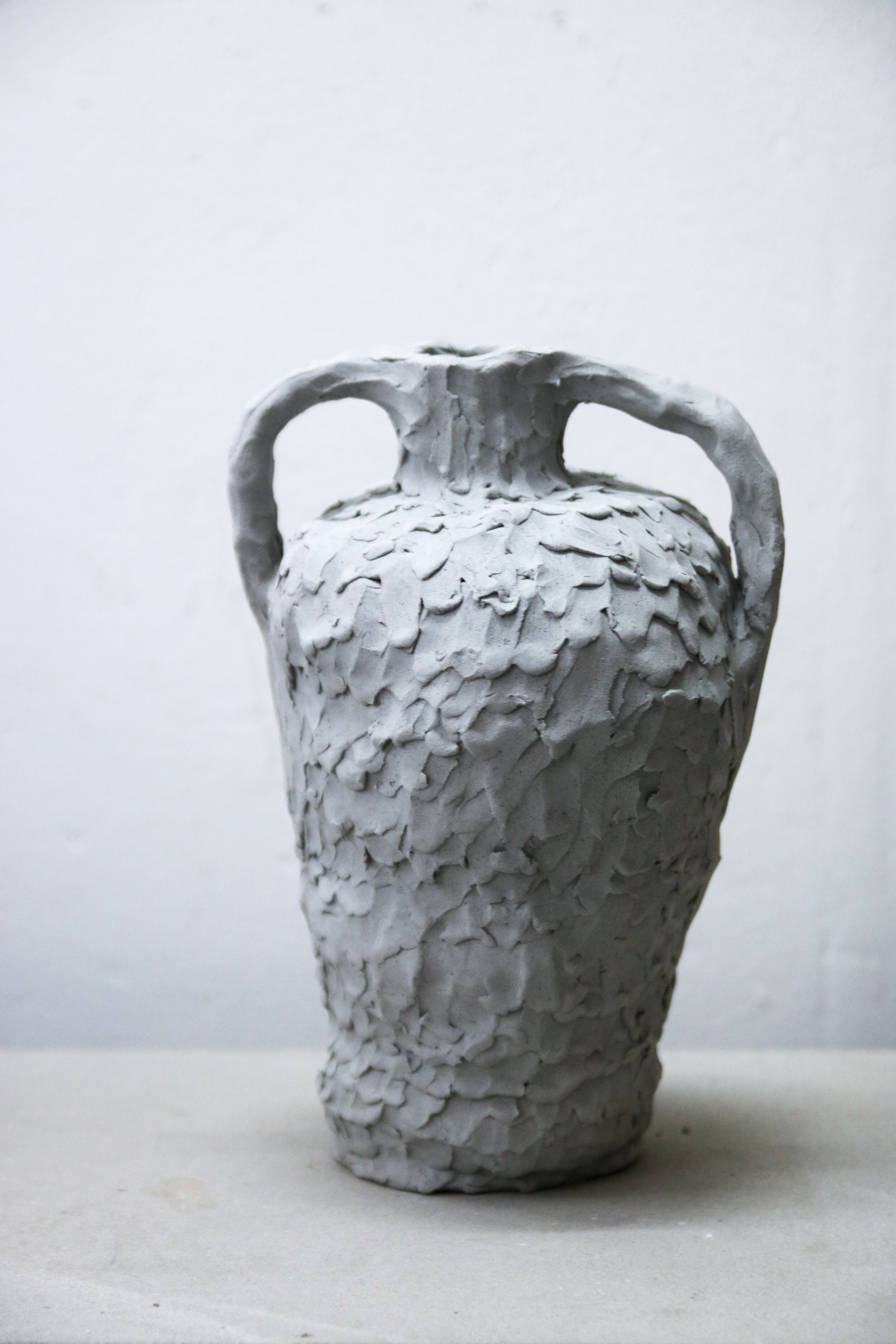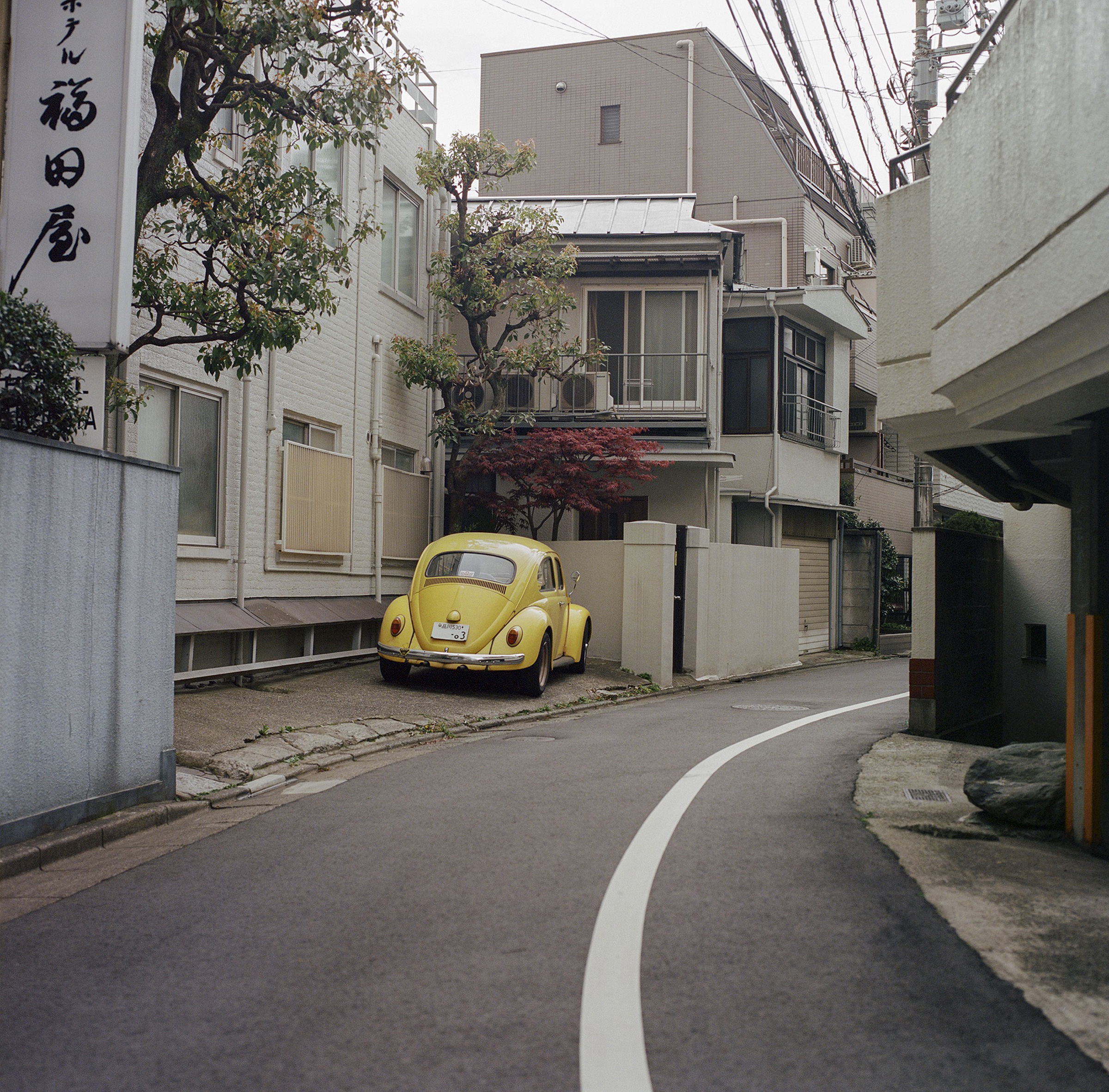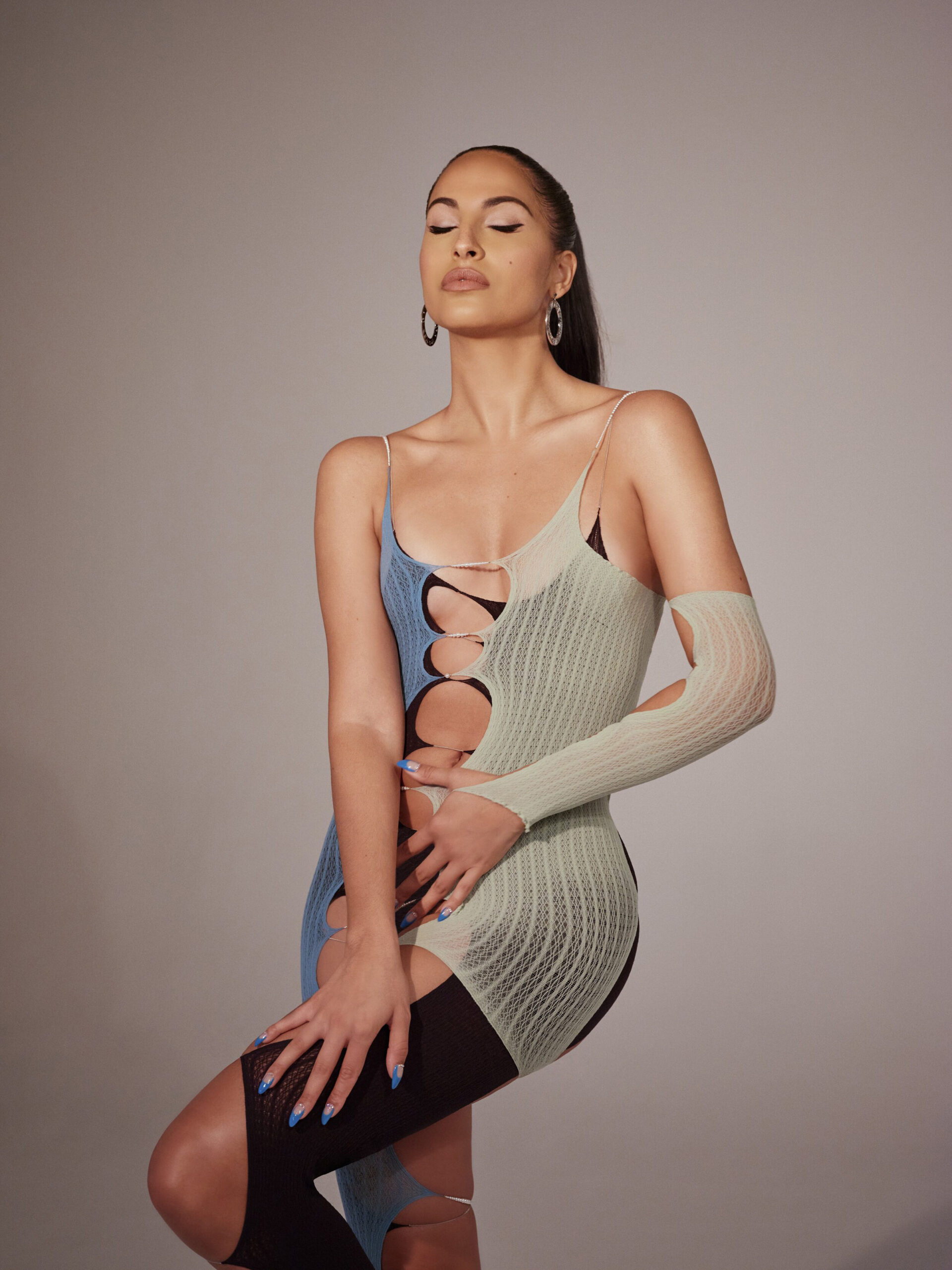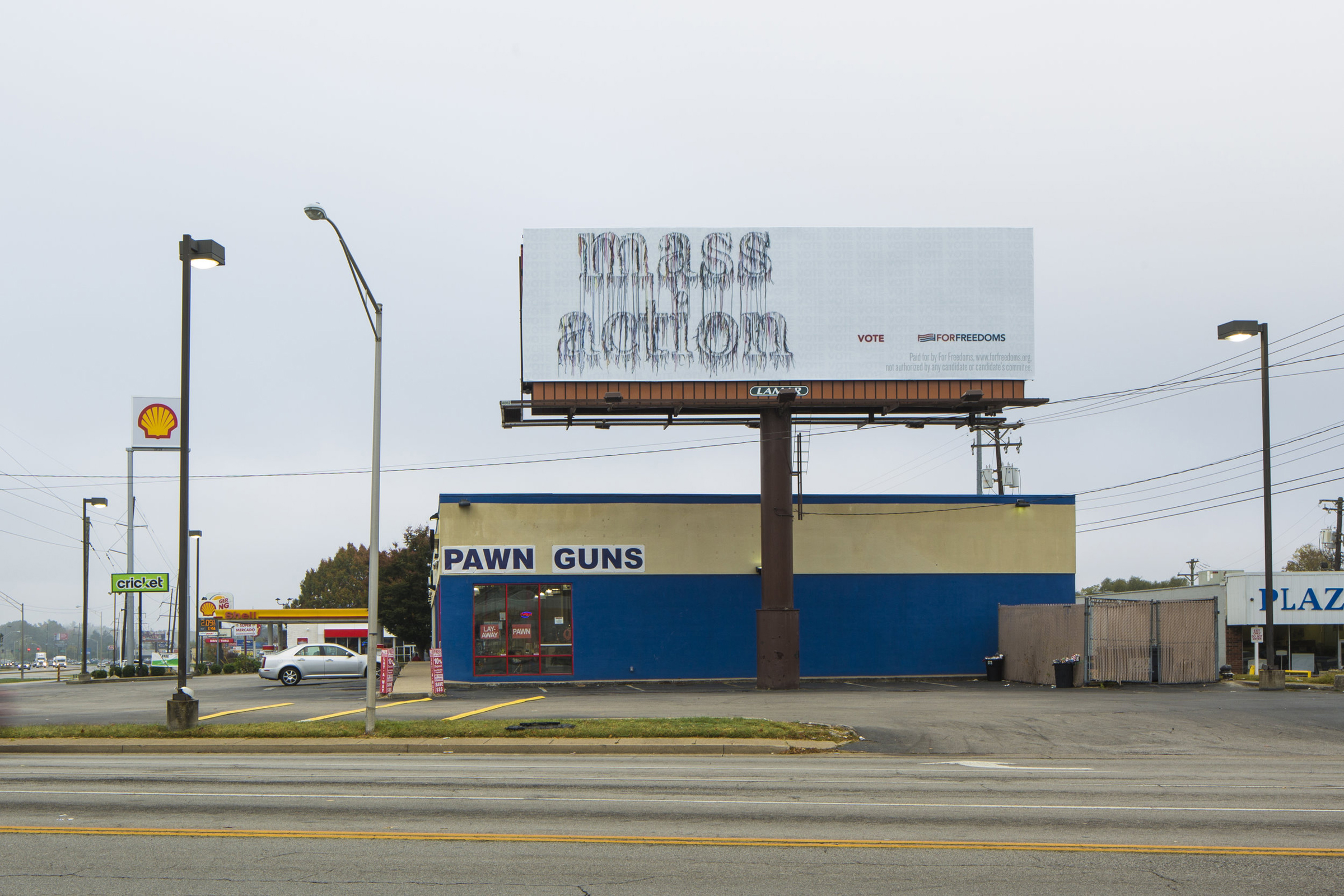
“I think colour brings so much energy and vibration”
Cassi Namoda takes archival images, memories and ruminations, and transforms them into vividly rich paintings, weaving an overarching theme throughout. Sometimes, there’s a clear narrative that informs her work, but at other times it can be a looser concept that has been on her mind.
Though many of the scenes and the characters within her paintings are imagined, they are drawn from concrete anecdotes. Take, for example, the character of Maria who often appears in her paintings. Maria embodies the way in which Cassi confront the history of her home country, Mozambique. Cassi saw a similarity between Ricardo Rangel’s photographs of downtown Maputo in the latter half of the twentieth century, and the work of European expressionists in the 1920s, where artists like Edvard Munch and George Grosz depicted scenes of a ‘very fucked up Europe’ at a period of turmoil and debauchery. Maria became a way for Cassi to explore this moment in Mozambique’s history, at a time when the country was going through revolution and dealing with its colonial past. Through the Nightly Bread series, Cassi depicts Maria’s navigations through the seedy underbelly of the city in a way that felt personal to her, given its proximity in recent history. There’s humour in these works too, in which, like Grosz, Cassi deliberately adds a twist on a serious scene – where, for example, Maria has spilled a glass of wine.
Those subtle, but carefully considered, symbols are also evident in the cover Cassi painted for Vogue Italia’s sustainability issue in January this year. The magazine commissioned eight artists to each design a cover for the issue, as a statement against the huge impact that fashion shoots have on the environment. Maria appeared on the cover, with a mosquito hovering sinisterly above her head; a symbol of how disease is an undeniable implication of the climate crisis that is not often contemplated. These issues have been preoccupying Cassi for a while, and as she explains below, the darkness that our future may hold is something that informed the work for her recent exhibition at the Pippy Houldsworth Gallery in London. The show’s title, Little Is Enough For Those In Love, was derived from an East African proverb, and its exploration of the polarities between ‘joy’ and ‘pain’ have taken on new meaning in the context of the current global pandemic we now find ourselves faced with.


In light of what’s currently happening, your recent exhibition at the Pippy Houldsworth Gallery touched upon the balance between joy and suffering, which is something that we’re all suddenly forced to confront.
Totally, and it’s fascinating to see how the West is adjusting, in relation to the rest of the world. At the end of 2019 and the beginning of this year,
“I had this sense of anticipation that we were entering biblical times.”
It felt as though the Pippy Houldsworth show was preparing for this. As artists, we might be okay or not, depending on how the market swings but, ultimately, it’s just art. I’m very aware of that, and for me, art isn’t about the currency. Instead, it’s about expressing a narrative so, in that sense, nothing’s really changed for me. But, it’s more a case of the impact it’ll have on daily negotiations – like, do I need this expensive yellow ochre, or should I just get this other cheaper one? I hope that this might become something beautiful, in terms of a discovery process. The Pippy Houldsworth show healed me in a way, so that I could be prepared for something to happen.
Did you anticipate this change when you were making the work for the show?
Well, I had my show, The Day A Monkey Is Destined To Die All Trees Becomes Slippery, at the François Ghebaly Gallery earlier in 2019, and there was an ominous presence in those paintings, with bold black lines and colour blocking. But, when it came to the Pippy Houldsworth show, it felt as though we needed something else. I wanted to be very sensitive. There were two directions my work took in the lead up to the show. There was the work I made while I was in East Hampton in early Autumn; I would take walks around 7am with my dog, and
“what I noticed was this slight melancholy that comes when seasons change, and I think, a part of human nature is having trouble accepting change.”
So, it felt quite cathartic to massage in the new season – and so, my work was more compositionally about the landscape, with a more detached gaze upon the figures. And then, in November, I did a residence in Oaxaca, Mexico, and there’s something so vibrational about the earth there. I was faced with challenges, logistically, where I was out of the comfort zone of being able to call people to deliver canvases or paints. Also, I mainly paint with acrylic, but it’s very dry in Oaxaca, so my paint was drying on the brush; intuitively, I’d brought a retarder with me, but I still needed to work in an immediate way. So, in the show, there’s these two styles of painting. There’s the very magical, illusive paintings – so you have the beach scene with the couple getting married, and then you might have something like the Mimi Nakupenda painting, with couples dancing and a lot of energy in the air.

You’ve got two upcoming exhibitions (one at Nina Johnson Gallery in May, and the other at the Goodman Gallery in the Autumn); do you know what you’ll be doing for these shows?
Yeah, I do. The Nina Johnson show most likely won’t open up in a physical sense, but it will still hang. There will be 8×10 inch paintings, and the show is called Dog Meat, Cat Meat, God Knows What Meat – it’s a little bit humorous because I wanted to do something that was dark, funny and also random. There’s no real narrative behind it. I want to do paintings of women that are in my life, so I’m using this time to do something that I’ve always wanted to do. I can’t paint them in the flesh now, but I’ll get friends from all around the world – Kenya, South Africa, New York – to send photos of themselves to paint from. And then, I’ve also been exploring medical imagery, in the sense that black bodies have been sold under the gaze of medical research, that never actually served the female body, but was instead a form of slavery. I’ve been researching Millie and Christine McKoy, who were these conjoined twins born into slavery in 1851 and were, by the age of 2 being exhibitioned around the world. I wanted to give them a renewed agency, so that they can now be part of the black community so that we can remember them in a more intimate way. And, then, I might also paint a random scene from a Djibril Diop Mambéty film that is special to me – so, the process is really open with this show, it’s more communicative of everything I’ve been thinking about.
As for the Goodman show, it will be a lot more narrative based. The show’s called To Live Long Is To See Much, which is very much about what we’re going through right now. I want to call my elders and ask for advice – like, what do we do in this situation? It’s such a strange time we’re living in. So I thought about this Swahili proverb, to live long is to see much, and I wanted to take an archival approach,
“looking at everything that I’ve found so fucking bizarre in slavery, in colonialism, and in the projection that black is bad. I thought about how the Christian epistemology of the world that we live in is actioned through a white gaze, and I want to question that.”
Why hasn’t that been challenged? I’ve also been looking at Pointillism, and then, after spending some time in Kenya, I realised that there’s this African Pointillism here too – it’s called Tingatinga, and I grew up with that type of painting! So, I am ruminating now on how I can combine some sort of folklore with a classical aspect of painting, because I love painters like Joaquín Sorolla and Paul Cezanne. But,
“there needs to be some duality; I want to make these beautiful paintings but also tell the truth.”

Do you consciously group series of paintings together with certain colour palettes?
I think colour brings so much energy and vibration. I definitely think I work with colour more consistently when I’m working on a show, much more so than when I’m painting in my studio for painting’s sake. I think there’s something spiritual in the process of negotiating with the paint that exists in a body of work. So, yeah – it’s something I’m very aware of and it’s super intentional. With the Pippy Houldsworth show, I wanted to convey healing through soft yellows, light blues, violets and pale greens – and then maybe some stronger colours like red. I feel like red is a very religious colour, and I’m relating colour to John Mbiti’s writings, where he talks about religious objects, like for example, a rock, in traditional African culture. And to me, a chair can be a religious symbol, so when Maria is sitting on a red chair, that’s her religious object. The red chair has become an ongoing symbol in my work. More recently, the symbol I’ve been using is this orange, reddish circle that ends up in the upper right of the canvas – sometimes the left depending on the composition – and that was there in a lot of the Pippy Houldsworth work. It’s a tool that draws you to the upper right corner and it’s a symbol that feels warm. When it comes to narrative, I think about the palette in its totality because, for me, I feel like it’s part of the story.
Photos
- Little is Enough for Those with Love/Mimi Nakupenda, 2019 acrylic on canvas 167.6 x 233.7 cm, 66 x 92 in Photographer Mark Blower
- Family Portrait in Gurué, 2019 acrylic on canvas167.6 x 121.9 cm, 66 x 48 in Photographer Todd-White Art Photography
- Sasha And Zamani’s Fruitful Earth, 2019 acrylic on canvas 188 x 152.5 cm, 74 x 60 in Photographer Mark Blower
- Visit From Ancestor, 2020 acrylic on canvas 101.6 x 76.2, 40 x 30 in Photographer Thomas Mueller
- Young Woman makes a dress in Quelimane, 2020 acrylic on cotton poly 101.6 x 76.2 cm, 40 x 30 in Photographer Mark Blower
